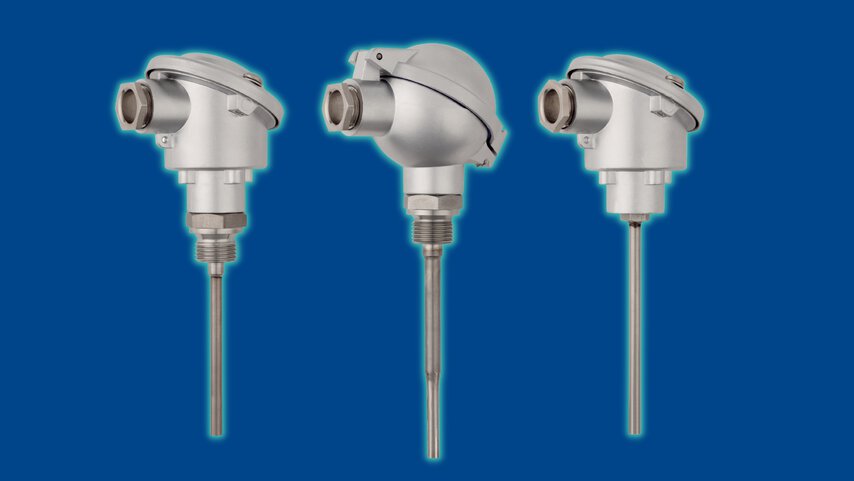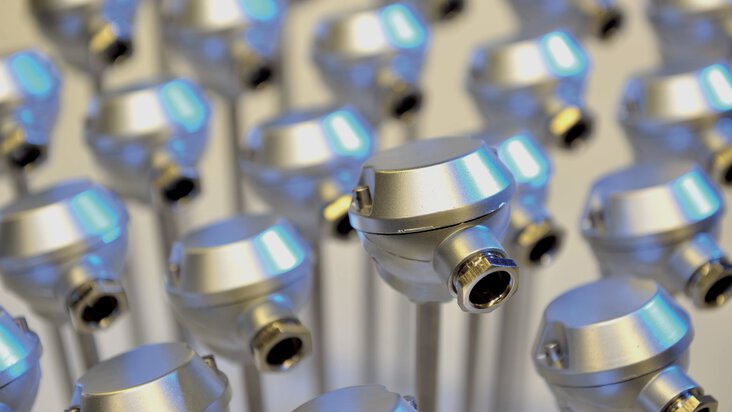

RTD accuracy class – PT100 according to IEC60751
Pt100 sensors are labelled with letters e.g. A or B, or F 0.3, F 0.15, etc. What does this mean exactly? Read on to find out what the tolerance classes are according to IEC 60751, what they entail and which class to choose for your application.
Pt100 temperature sensor – characteristics
The Pt100 temperature sensor is the most widely used temperature measurement solution in industry. It owes its popularity to the long-term stability of the platinum from which it is made, as well as the high accuracy and repeatability of its measurements.
Rtd sensor accuracy
Resistance temperature sensors (RTDs) are more accurate and have a higher measurement resolution than, for example, thermoelectric sensors (thermocouples). However, there are no perfect temperature measuring devices and RTD measurements also have some deviations. The permissible error tolerances for platinum resistance temperature sensors are precisely defined in the international standard IEC 60751 (Polish PN-EN 60751).
Importance of the international standard IEC 60751
The IEC-60751 standard establishes the resistance value of resistors as a function of temperature and defines their tolerance classes. In terms of the standard, the tolerance is the maximum permissible deviation from the nominal static characteristic (NSH), expressed in degrees Celsius.
Class vs RTD accuracy
There are four tolerance classes (from 'best' to 'worst'): AA, A, B, C, which differ in temperature accuracy.
It should be noted that the tolerance class of resistance thermometers does not depend on its type (platinum, copper, nickel) or on the measuring element (resistor). The tolerance class depends only on the temperature tolerance value.
Resistor and thermometer – differences
In the revision of IEC 60751, the distinction between resistors and resistance thermometers was made for the first time.
Resistor characteristics
Resistors are constructed in platinum wire (wire resistors) or a thin layer of platinum (thin film resistors). They are designed to be installed in resistance thermometers.
Resistance thermometer characteristics
According to the standard, a resistance thermometer consists of a resistor embedded in a sheath tube, connecting wires and mounting elements or connection heads.
Pt100 in class B or F 0.3 – what does the IEC 60751 standard say?
The IEC standard has been revised as some discrepancies have emerged from research by equipment manufacturers, including that thin-film resistors at high temperatures have been found to have lower accuracy than that described in the standard. Recent studies have also shown that the characteristics of a resistor differ when tested under laboratory conditions compared to when it is mounted in a thermometer. Consequently, a separate classification into accuracy classes for resistors has been created.
The different temperature ranges for Pt100 in the wire version and the thin-film version have also been taken into account. Pt100 sensors in the wire version have classes W 0.1, W 0.15 , W 0.3 and W 0.6 (W from 'Wire Wound'). Layer resistors, on the other hand, come in classes from F 0.1 to F 0.6 (F from 'Thin Film').
RTD (Resistance Temperature Detector) accuracy class
Pt100 class A
A Pt100 temperature sensor in class A has:
-
a limit value error of ± (0.15+0.002 * t), giving ±0.15 °C for 0 °C and ±0.35 °C for 100 °C
-
a temperature range for thin-film resistors of -30 to +300 °C
-
a temperature range for wire-wound resistors of -100 to +450 °C
Pt100 class B
Class B temperature sensor has:
-
a limit value error of ± (0.3+0.005 * t), giving ±0.3 °C for 0 °C and ±0.8 °C for 100 °C
-
a temperature range for thin-film resistors of -50 to +500 °C
-
temperature range for wire-wound resistors, which is -196 to +600 °C

Accuracy classes of pt100 resistors according to IEC 60751

Accuracy classes of pt100 thermometers according to IEC 60751
Which tolerance class to choose?
The tolerance class should not be the first feature you look at when choosing a resistance thermometer. As is usually the case, the choice of class depends on the type of application:
-
Class C resistance thermometers have the lowest cost and are therefore widely used in applications where tolerances of more than 1°C are acceptable.
-
Class B resistance thermometers have the best combination of tolerance class and price and are most commonly used in industrial settings.
-
Class A temperature sensors are used in the energy industry to determine the temperature of the heat transfer medium with maximum accuracy.
-
Class AA probes, which have ultra-high precision and accuracy, are used for temperature measurement only in research and scientific applications.
- ${title}${badge}

